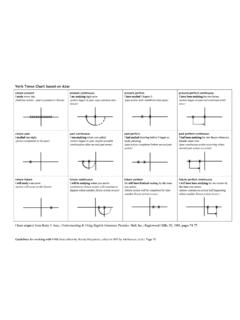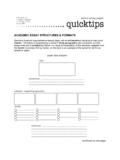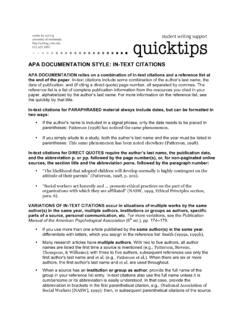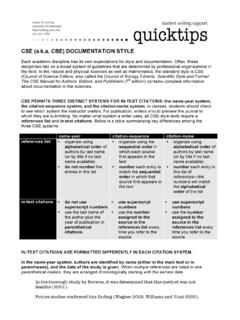Transcription of Writing Theory and Practice in the Second Language ...
1 Writing Theory and Practice in the Second Language Classroom: A. Selected Annotated Bibliography Torild Homstad &. Helga Thorson for 1993-94 Grant Recipients Karen Grimstad and Ray Wakefield Professors, Department of German, Scandinavian, and Dutch Technical Report Series No. 8 1994. Lillian Bridwell-Bowles, Series Editor Writing Theory and Practice in the Second Language Classroom: A. Selected Annotated Bibliography Torild Homstad &. Helga Thorson for 1993-94 Grant Recipients Karen Grimstad and Ray Wakefield Professors, Department of German, Scandinavian, and Dutch Technical Report Series No. 8 1994. Lillian Bridwell-Bowles, Series Editor Mark Olson, Editor THE CENTER FOR INTERDISCIPLINARY STUDIES OF Writing . UNIVERSITY OF MINNESOTA. 227 LIND HALL. 207 CHURCH STREET MINNEAPOLIS, MN 55455. Director: Lillian Bridwell-Bowles, Associate Professor, English Research Assistants: Elaine Cullen, Kathleen Sheerin Devore, Michael Kuhne, Kimberly Lynch, Pamela Olano, Mark Olson Policy Council: Terence Collins, Professor, General College; Jeffrey Derby, Assistant Professor, Chemical Engineering, Institute of Technology; Emily Hoover, Associate Professor, Horticultural Science; Gerald Rinehart, Director of Undergraduate Studies, Carlson School of Management.
2 Ray Wakefield, Associate Professor, German, Scandinavian, and Dutch. Faculty Affiliates: Chris Anson, Professor, English, Director of Program in Composition and Communication; Lisa Albrecht, Associate Professor, General College; Robert L. Brown, Associate Professor, English; Ann Hill Duin, Associate Professor, Rhetoric; Donald Ross, Professor, English; Geoffrey Sirc, Associate Professor, General College; Billie Wahlstrom, Professor, Rhetoric. Copyright 1994 by The Board of Regents, University of Minnesota All Rights Reserved ISBN 1-881221-17-2. The University of Minnesota is committed to the policy that all personnel shall have equal access to its programs, facilities, and employment without regard to race, color, creed, religion, national origin, sex, age, marital status, disability, public assistance status, veteran status, or sexual orientation.
3 Preface In the 1993-94 academic year, members of the Department of German, Scandinavian, and Dutch embarked on a Center-sponsored research project investigating the role of Writing in Second Language acquisition. As Torild Homstad and Helga Thorson point out in their introduction to this bibliography, Writing has long been considered a support skill for learning grammar in foreign Language instruction. Their research looked beyond traditional Writing practices in Second Language acquisition for new instructional possibilities. One aspect of the project was to search current literature in composition studies, foreign Language instruction, and English as a Second Language . Their annotations show that a number of theorists and practitioners in Second Language instruction are pushing the boundaries of standard Language instruction practices by adapting methods familiar to composition studies.
4 For example, foreign Language instructors are stressing the process approach to Writing using and Writing -to-learn strategies. Homstad and Thorson offer a particularly helpful introduction to the wide range of opinions and practices concerning Writing among foreign Language instructors. For those engaged in foreign Language and English as a Second Language instruction, the bibliography annotates articles concerned with both theoretical and practical aspects of Writing instruction. The bibliography is also helpful for introducing composition theorists and practitioners to new sites for thinking about literacy. The Center for Interdisciplinary Studies of Writing annually funds research projects by University of Minnesota faculty to study any of the following topics: characteristics of Writing across the University's curriculum.
5 Status reports on students' Writing ability at the University;. the connections between Writing and learning in all fields;. the characteristics of Writing beyond the academy;. the effects of ethnicity, race, class, and gender on Writing ; and curricular reform through Writing . We publish informal reports on the projects, such as this bibliography by Homstad and Thorson, available in the form of technical reports. More elaborate reports and extended discussions of Center grant recipients' works are available through our monograph series. One of the Center's goals is to disseminate the results of these research projects as broadly as possible within the University community and on a national level. We encourage discussion of Torild Homstad and Helga Thorson's annotations and interpretations of the literature currently available on using Writing in the foreign Language classroom.
6 We invite you to contact the Center for Interdisciplinary Studies of Writing for information about other publications or Center activities. Lillian Bridwell-Bowles, Series Editor Mark Olson, Editor September 1994. Writing Theory and Practice in the Second Language Classroom: A Selected Annotated Bibliography This annotated bibliography on Second Language Writing provides an overview of some of the major ideas and resources concerning the role of Writing in the Second Language classroom. It contains both hands-on material directly applicable to the Language classroom and articles, which trace the historical and theoretical development of Writing pedagogy in Second Language education. The bibliography is part of a grant funded by the Center for the Interdisciplinary Studies of Writing at the University of Minnesota to investigate ways in which Writing -to-learn activities can most effectively be used in the foreign Language (FL) classroom.
7 As theories of Second Language education have evolved from the grammar- translation to the audio-lingual method to the more communicative approaches that are commonly used today, ideas about how Language proficiency develops and ought to be taught have also changed. Writing has commonly been viewed as a support skill, used to reinforce the acquisition of grammar, as in the grammar-translation method, or to support the memorization of CO1 TeCt Language structures, as in the audio-lingual method. Until recently, even the communicative approaches, with their emphasis on oral proficiency, have tended to de-emphasize Writing . But ideas from Writing -to-learn, Writing across the curriculum, and Writing for academic purposes movements in composition and English as a Second Language (ESL) have all had an impact on thinking about the place of Writing in Second Language education.
8 There is ample evidence to indicate the ineffectiveness of micro-correcting student Writing in developing Language competencies. More research needs to be done on how 2 Homstad and Thorson basic Second Language literacy can best be developed by those who are already literate in a first Language . Until we know more about how Second Language students learn to write correctly, actual classroom practices will be slow to change. Although the research on Writing originally done in composition studies forms the basis for what is happening in Second Language Writing research, we have, for the most part, not included these former studies in our bibliography. Most of the current research in Second Language Writing has been conducted by ESL professionals; however, we also found many practical articles illustrating the uses of Writing in FL, and ESL classrooms.
9 We have included theoretical and historical articles so teachers can think about their own vision of Language teaching and place it in a theoretical perspective , along with hands- on articles that demonstrate effective uses of Writing in actual foreign Language classes. For example, a couple of authors indicate how the appropriate and creative use of word processing may be a powerful tool in teaching Second Language Writing . However, there are also those who are still highly skeptical about the importance of Writing in foreign Language curriculum; they are represented by three articles in this bibliography. Much exciting and important work is yet to be done in exploring the relationship of the four modalities (listening, reading, speaking, and Writing ) to each other in Second Language acquisition, as well as determining the relationship between first and Second Language literacy.
10 Our goal in preparing this annotated bibliography has been to learn more about the Theory and Practice of Writing pedagogy in order to make better use of it in our own teaching as well as to make these ideas and resources available to our colleagues. Although research on Writing in Second Language acquisition is a relatively new field, we found so much exciting material that it was difficult to decide where we Writing Theory and Practice in the Second Language Classroom 3. should stop adding citations. We hope that our readers will find these resources equally thought-provoking and inspiring. 4 Homstad and Thorson Bibliography Anson, Chris M., et al. Scenarios for Teaching Writing : Contexts for Discussion and Reflective Practice . Urbana, Illinois: National Council of Teachers of English, 1993. The authors of this book provide scenarios about various aspects of teaching Writing .










